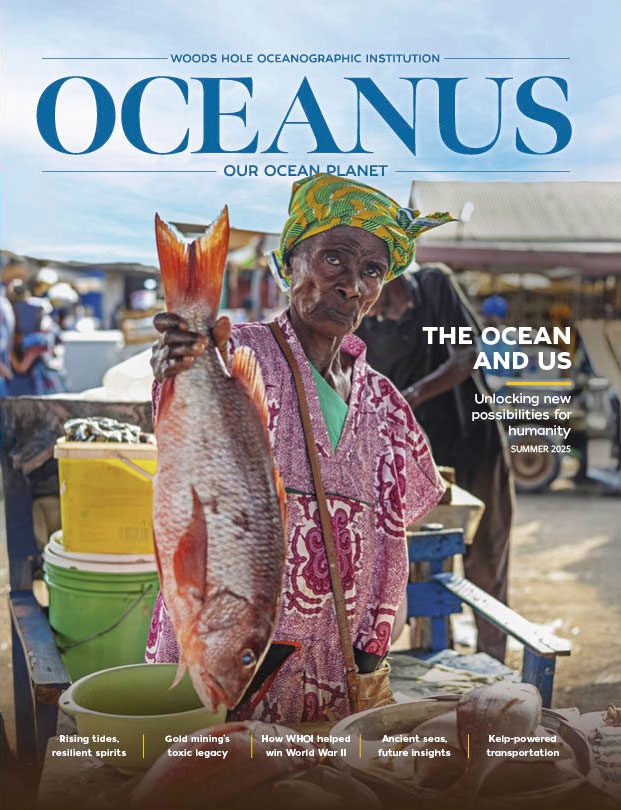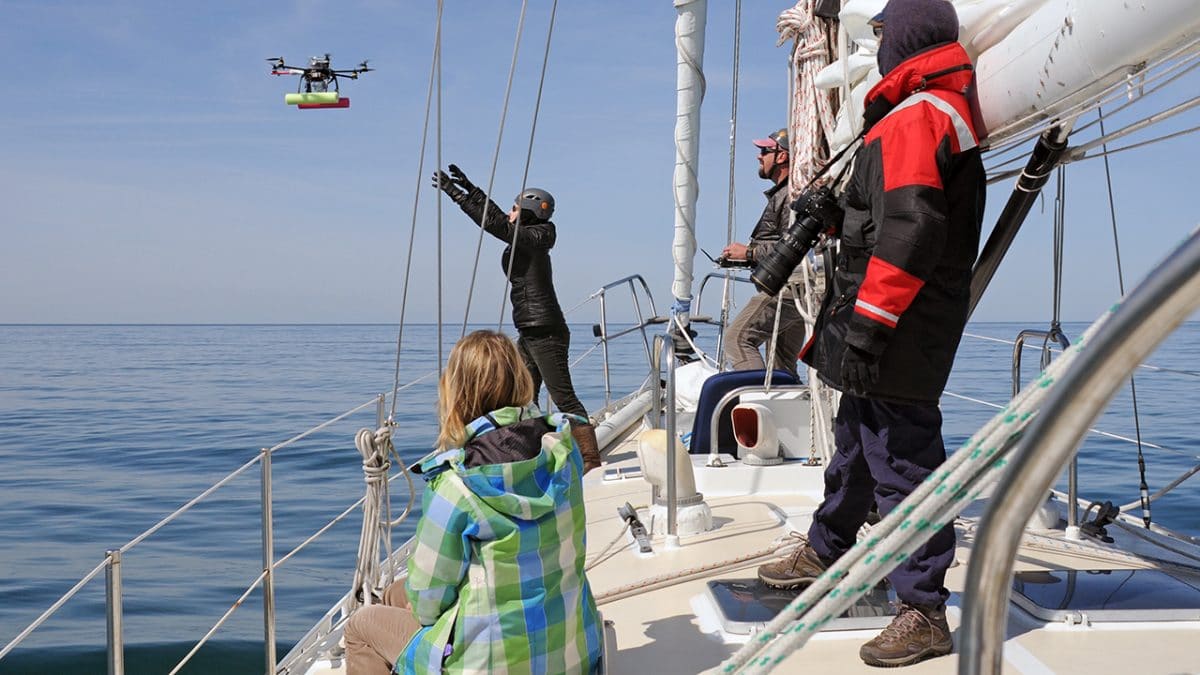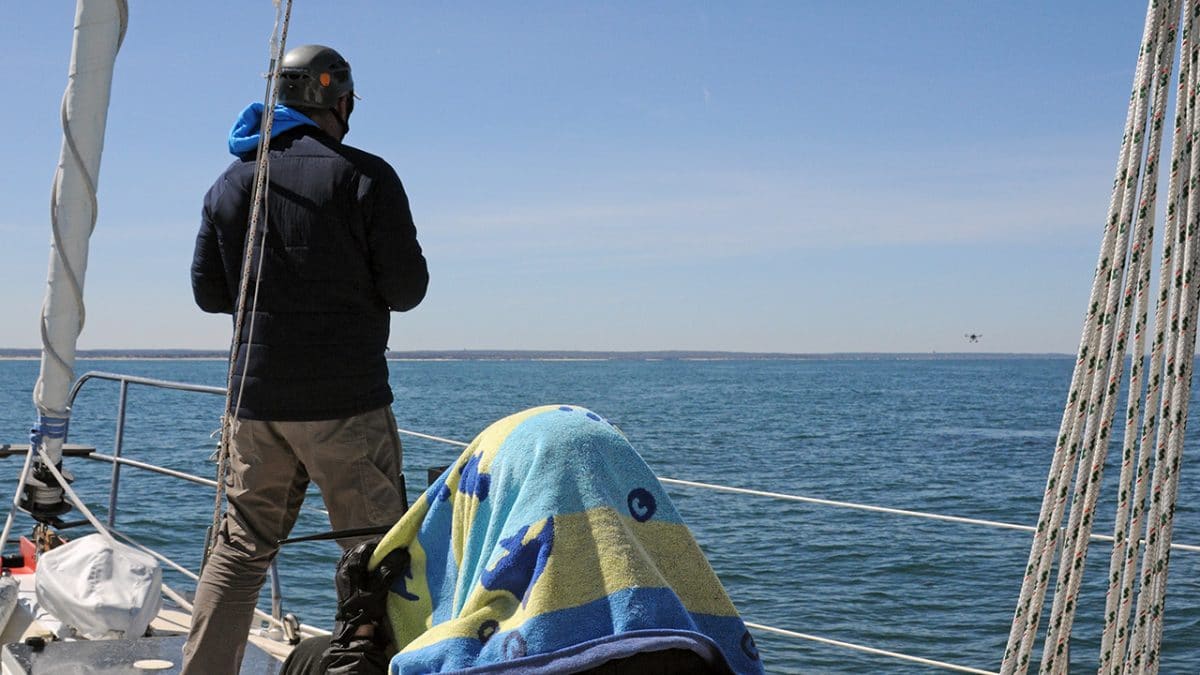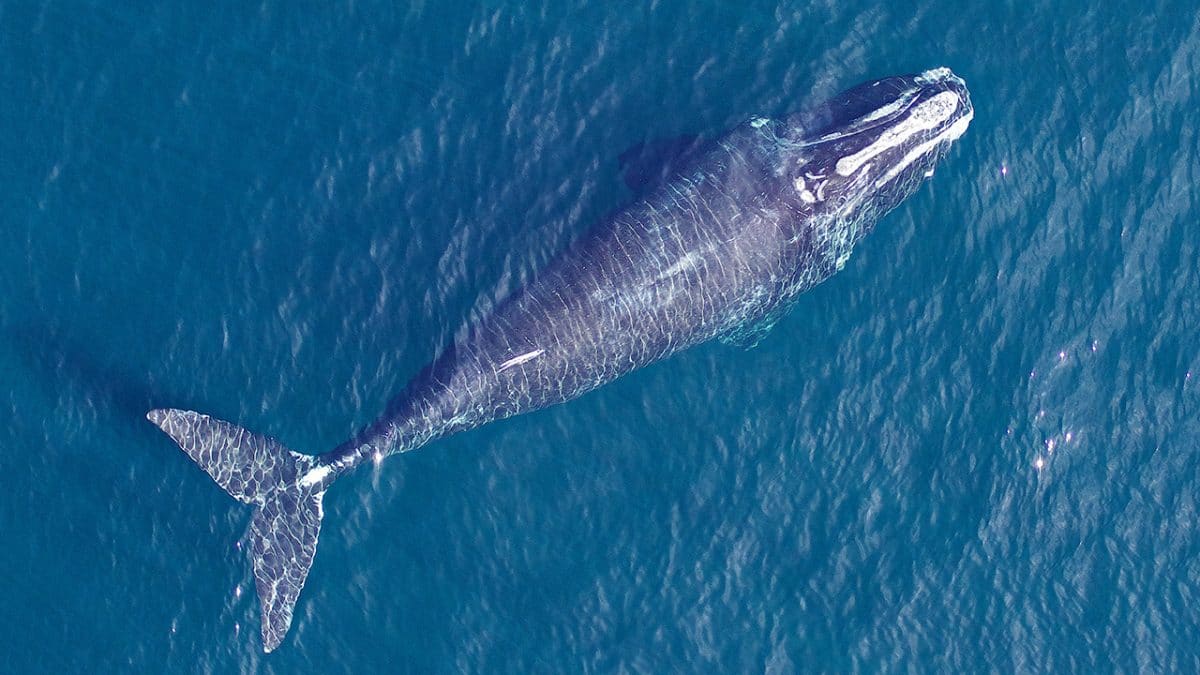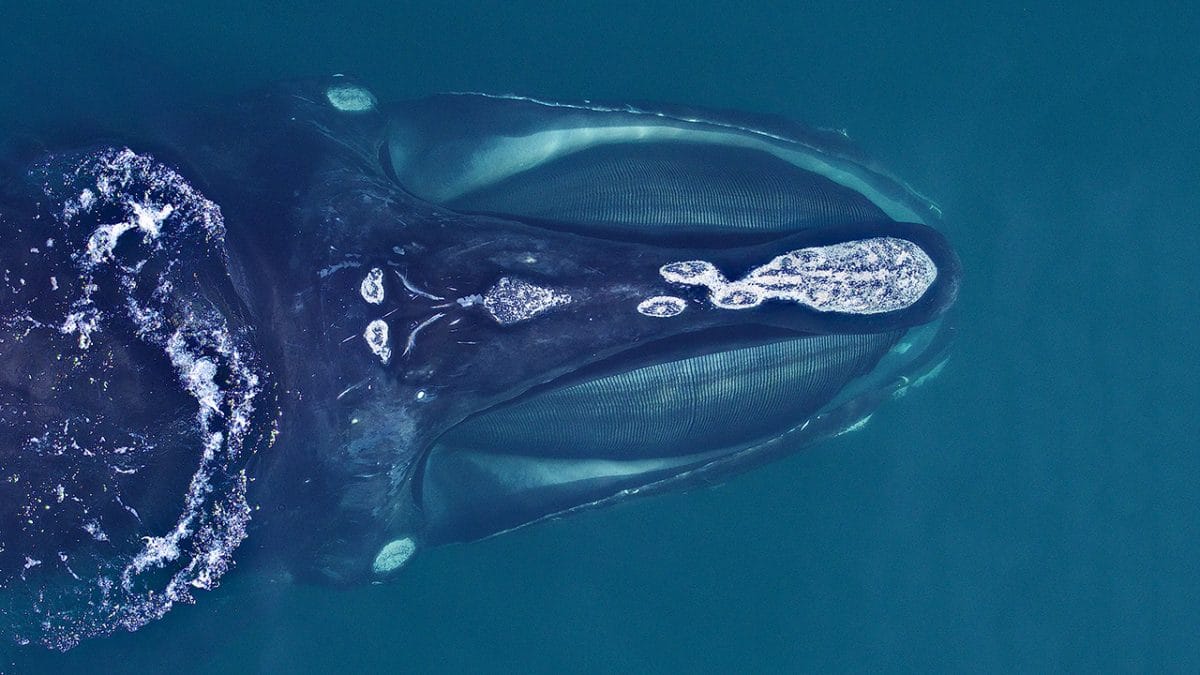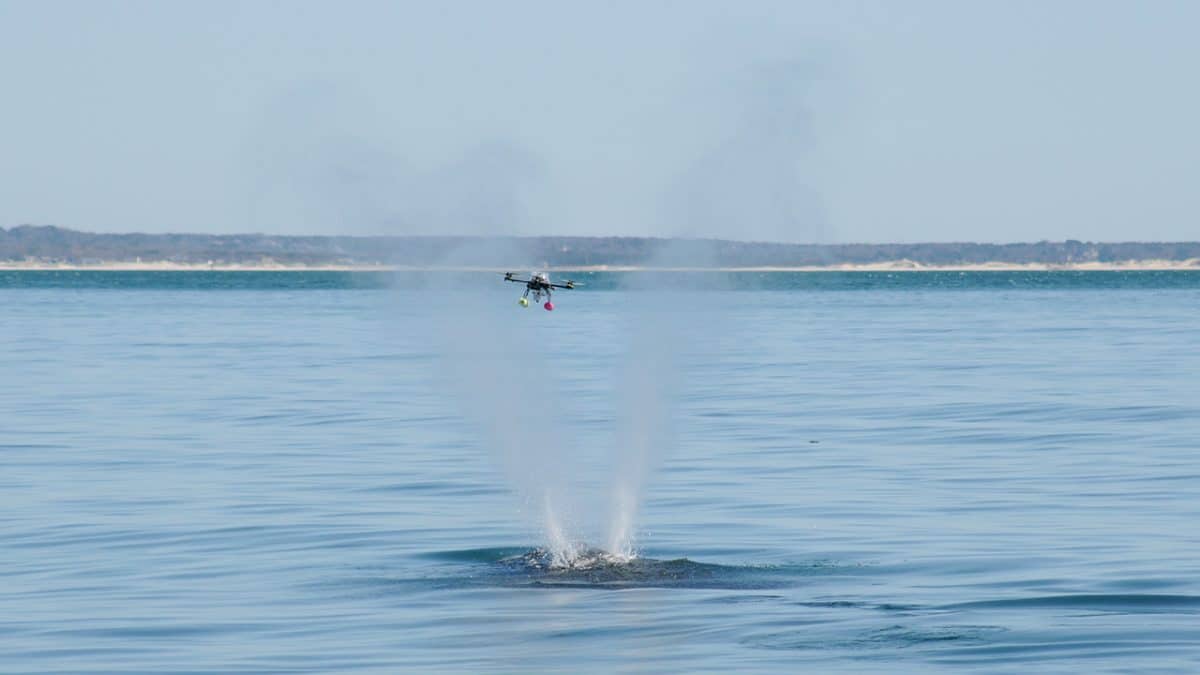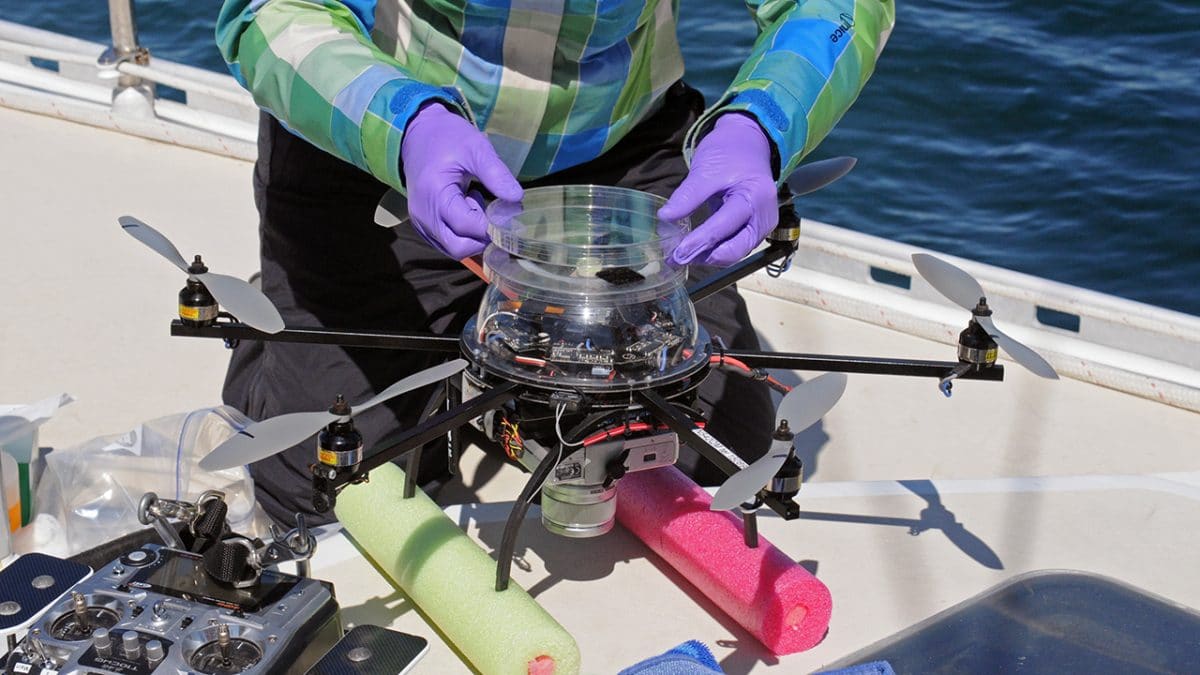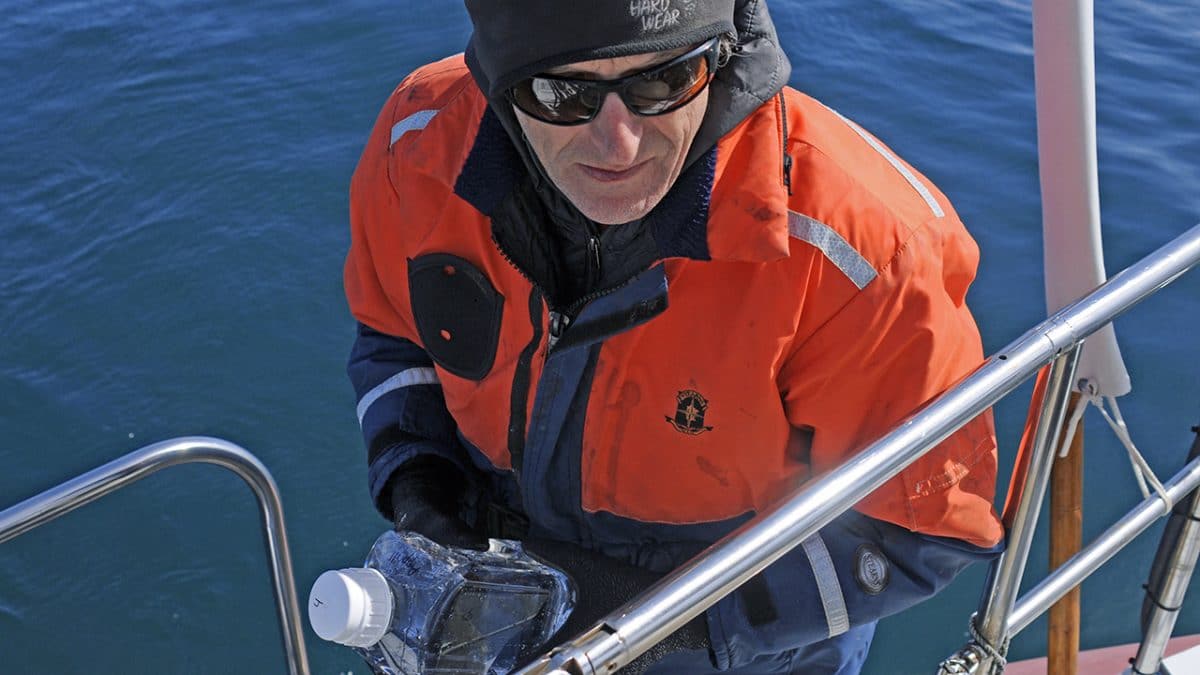- Drones are providing a powerful new tool for whale research and conservation. Here, NOAA’s John Durban (center rear) uses a remote control to guide a hexacopter into the outstretched hands of his NOAA colleague, Holly Fearnbach, as WHOI microbiologist Amy Apprill (seated) and New England Aquarium whale specialist Marilyn Marx look on. Durban makes it look easy, but maneuvering a drone from a rocking sailboat is anything but. (Photo by Véronique LaCapra, Woods Hole Oceanographic Institution)
- Sitting on the deck in the bright sunlight, Fearnbach uses a towel to shade a monitor screen showing a video feed from the drone’s camera. By looking at the video, Fearnbach sees what the camera “sees” in real time—and can tell Durban which way to fly the drone in order to position it over a whale to take high-resolution images and sample its blow. (Photo by Véronique LaCapra, Woods Hole Oceanographic Institution)
- In the past, getting aerial photographs of whales meant taking them from a plane or helicopter. A small drone equipped with a specialized camera can get close to a whale without disturbing it, resulting in images of unprecedented quality and detail. In a process known as photogrammetry, a team led by NOAA’s Wayne Perryman will use the images to estimate the size of the whales, assess their body condition, and draw conclusions about their overall health. Research approach of whales using the hexacopter was authorized by NMFS permit #17355 and flights were authorized under an MOU between NOAA and the FAA (Class G MOU #2016-ESA-3-NOAA). (Photo by John Durban and Holly Fearnbach, NOAA Southwest Fisheries Science Center, and Michael Moore, Woods Hole Oceanographic Institution)
- This close-up image was taken as the drone approached a whale to collect a sample of its blow; the animal's still-closed blowholes are visible as two slits in the center of its head. The whale is filter-feeding on tiny crustaceans near the surface of the water, so its mouth is open, revealing its baleen plates. High-resolution photographs like this one allow scientists to identify individual whales by their unique pattern of callosities—the patches of rough skin on the whale’s head. The dark callosities are covered with light-colored cyamids or “whale lice,” making them appear white. Research approach of whales using the hexacopter was authorized by NMFS permit #17355 and flights were authorized under an MOU between NOAA and the FAA (Class G MOU #2016-ESA-3-NOAA). (Photo by John Durban and Holly Fearnbach, NOAA Southwest Fisheries Science Center, and Michael Moore, Woods Hole Oceanographic Institution)
- The drone hovers in the whale’s blow to collect a sample. The V-shaped spray pattern is characteristic of baleen whales such as North Atlantic right whales, which have two blowholes through which they breathe. Whales with teeth—such as sperm whales—have only one blowhole. Research approach of whales using the hexacopter was authorized by NMFS permit #17355 and flights were authorized under an MOU between NOAA and the FAA (Class G MOU #2016-ESA-3-NOAA). (Photo by Véronique LaCapra, Woods Hole Oceanographic Institution)
- To get a sample of a whale’s blow, the researchers attach a sterilized petri dish to the top of the hexacopter. After a successful flight, they transfer the collected liquid to a small plastic vial and freeze it. Back at WHOI, Apprill and her colleague Carolyn Miller will use a technique known as metagenomics to analyze genetic material and identify microbes in the blow. (Photo by Véronique LaCapra, Woods Hole Oceanographic Institution)
- WHOI biologist Michael Moore collects a sample of seawater off the back of the boat. Apprill and Miller will compare the water’s microbial community to what they find in each blow sample, to distinguish microorganisms that live in the water from those specific to a whale’s respiratory tract. Respiratory system microbes are the most common source of disease in whales. (Photo by Véronique LaCapra, Woods Hole Oceanographic Institution)
Scientists Reveal Secrets of Whales
Thar she blows!
Researchers have known for decades that whales create elaborate songs. But a new study has revealed a component of whale songs that has long been overlooked—sort of a booming baseline to go along with the treble.
Aboard a small research boat, a research team measured two elements of songs from a group of humpback whales off the coast of the Hawaiian island of Maui—pressure waves (the type of sound waves that push on human eardrums, allowing us to hear), and particle motion (the physical vibration of a substance as sound moves through it).
“Imagine pulling up next to a car blasting loud music,” said Aran Mooney, a biologist at Woods Hole Oceanographic Institution. “The stuff you hear is pressure waves; the stuff you feel vibrating your seat is particle motion.”
To the scientists’ surprise, they found that particle motion in the water was detectable much farther than expected.
“We threw our gear over the side and let ourselves drift away from whales while measuring both particle motion and sound pressure,” Mooney said. “We didn’t expect particle motion to be detectable much at all—just a few meters away at most. But as we got progressively farther away, the particle motion stayed loud and clear.”
Mooney and his colleagues—WHOI graduate student Maxwell Kaplan and Marc Lammers of the Hawaii Institute of Marine Biology—measured only as far as about 655 feet (200 meters) from the whales, but their data show that particle motion from the whale songs, especially in lower frequencies of sound, could travel much farther.
“It’s a whole other avenue of sound that we never knew whales could use,” Mooney said. “When it comes to whale songs, particle motion hasn’t really been studied much. It’s a lot more complex to measure than pressure waves, so we don’t have a great sense of how it propagates in water or air.”
Pressure waves are relatively simple to detect using common underwater microphones called hydrophones. Detecting particle motion, however, requires sensitive underwater instruments such as accelerometers, which until recently have not been widely used by researchers to measure sound. Mooney and his team had both sensors on hand, allowing them to collect their unexpected recordings.
Mooney is quick to note that his team didn’t gather enough data to say definitively whether these whales could sense the particle motion present, but the anatomy of whale ear bones suggests that low-frequency vibrations could play a major role in whale hearing. Unlike those in dolphins and toothed whales, humpback whale ear bones are fused to the animals’ skull, providing a direct link to conduct vibrations in the water through their bones to their ears.
“It raises the question: Does a whale’s lower jaw act like a tuning fork to direct vibrations to their ears?” Mooney said. “Previous studies have shown this bone conduction might be a viable mode of hearing.”
There’s also some evolutionary precedence. Whales’ closest living relatives—hippopotamuses—can sense sound under water using their bodies, even while their ears remain above the surface. Elephants, another close relative of whales, can pick up ultralow-frequency vibrations through their feet, a trait that may help them locate their herd from miles away.
The new findings also raise another concern: Increasing human activity—from shipping, seismic exploration for oil and gas, and construction using pile-driving machinery—probably increases low-frequency particle motion that might propagate for miles under water and might interfere with whale communication.
“We humans don’t hear well in water, so we overlook noise in the ocean,” Mooney said, “but this could be a major concern for whales.”
The study was published in November 2016 in the journal Biology Letters. It was funded by a WHOI Independent Study Award.
